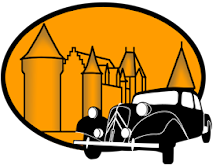Scientific Name: Rhinolophus ferrumequinum (Rhinolophidae).
English Name: Greater Horseshoe Bat (Horseshoe bat family).
French Name: Grand rhinolophe (='large crested nose'); Grand rhinolophe fer à cheval (='large horseshoe crested nose'); Grand fer à cheval (='large horseshoe'); Grand rhinolophe obscur (='sombre large crested nose').
5 Key Characters:
- the largest horseshoe bat in Europe.
- echolocation frequency strongest at 81 kHz.
- distinctive 'noseleaf', pointed above and horseshoe shaped below (used for focusing the echolocation signals).
- about 65 mm long with a 400 mm wingspan.
- grey brown on the back, grey white underneath.
Lookalikes: Lesser Horseshoe Bat Rhinolophus hipposideros, which is smaller.
Habitat: Hunts over pasture, deciduous woodland, gardens and scrub. Roosts in cellars and abandoned underground quarries (caves) as well as roofspaces in the summer if the building has suitable cellars for winter hibernation and nearby hunting grounds. Their diet is mainly Noctuid moths (in summer) and dung beetles (in spring), but they also eat wasps, flies (such as crane flies in autumn when the bats need to fatten up prior to hibernating) and cockchafers.
Active Period: April - September.
Status: Widespread and not uncommon. The population is probably stable, but threatened by habitat fragmentation, intensive forestry and agricultural management such as cattle feedlots and grubbing up hedges, declines in insect populations due to pesticides such as Ivermectin (which affects larvae in cattle dung), disturbance of underground and attic roosts.
Photographed by Loire Valley Nature:








No comments:
Post a Comment